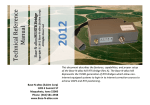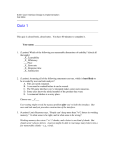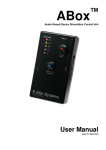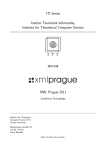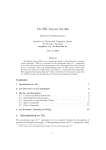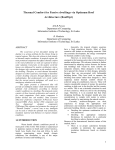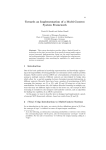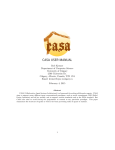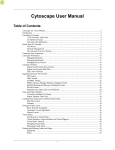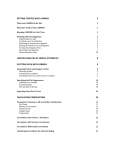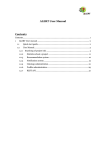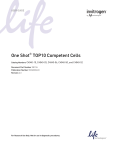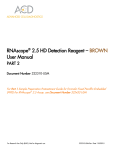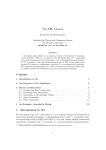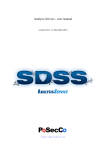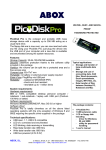Download LA Generator - Computer and Network Security Group
Transcript
LA Generation Service - programmer manual Politecnico di Torino version 0.2.0 - 13 December 2013 http://www.posecco.eu LA Generation Service - programmer manual Contents 1 Introduction 2 2 Software architecture 3 Implementation . . . . . . . . . . . . . . . . . . . . . . . . . . . . . . . . . . . . . . . . . . . . . 3 Plug-ins . . . . . . . . . . . . . . . . . . . . . . . . . . . . . . . . . . . . . . . . . . . . . . . . . 4 Metrics . . . . . . . . . . . . . . . . . . . . . . . . . . . . . . . . . . . . . . . . . . . . . . . . . 6 Public APIs 8 The model . . . . . . . . . . . . . . . . . . . . . . . . . . . . . . . . . . . . . . . . . . . . . . . . 8 TBox module . . . . . . . . . . . . . . . . . . . . . . . . . . . . . . . . . . . . . . . . . . . . . . 9 ABox module . . . . . . . . . . . . . . . . . . . . . . . . . . . . . . . . . . . . . . . . . . . . . . 10 Low-level mapper . . . . . . . . . . . . . . . . . . . . . . . . . . . . . . . . . . . . . . . . . . . . 11 Enrichment . . . . . . . . . . . . . . . . . . . . . . . . . . . . . . . . . . . . . . . . . . . . . . . 13 The LA extraction . . . . . . . . . . . . . . . . . . . . . . . . . . . . . . . . . . . . . . . . . . . . 16 Extending the tool 18 Developing a new UI . . . . . . . . . . . . . . . . . . . . . . . . . . . . . . . . . . . . . . . . . . 18 Adding a new phase in the refinement . . . . . . . . . . . . . . . . . . . . . . . . . . . . . . . . . 18 Adding new low-level mappers . . . . . . . . . . . . . . . . . . . . . . . . . . . . . . . . . . . . . 19 The eu.posecco.sdss.lageneration.lowlevel.modules extension point . . . . . . . . . . . . 19 The LowLevelMapper class . . . . . . . . . . . . . . . . . . . . . . . . . . . . . . . . . . 20 Adding new enrichment modules . . . . . . . . . . . . . . . . . . . . . . . . . . . . . . . . . . . . 20 The eu.posecco.sdss.lageneration.enrichment.modules extension point . . . . . . . . . . 21 The SmartClassifier class . . . . . . . . . . . . . . . . . . . . . . . . . . . . . . . . . 22 The AggregationDiscoverer class . . . . . . . . . . . . . . . . . . . . . . . . . . . . 23 Modifying the PoSecCo ontology . . . . . . . . . . . . . . . . . . . . . . . . . . . . . . . . . . . . 23 3 4 1 / 25 LA Generation Service - programmer manual 1 Introduction This document provides an overview of the LA Generation Service from the developer’s point of view. It is considered a companion of the ‘LA Generation Service - user manual’ in which the use of the LA Generation Service and its UI are described. The LA Generation Service is used to transform a set of policies into logical associations (LAs). This process is known as policy refinement. For further information regarding the policy refinement process and the LA generation see ‘D3.5 - Models to refine the IT policy at service level’. This service is a complex toolbox containing a number of specialized modules which are presented in depth in the following sections including their APIs, their dependencies and a how to extend them. This document is structured as follows. The Section 2 is devoted to explain the LA Generation Service internal structure by providing a bird’s eye view of its architecture, its plug-ins and its types. The Section 3 describes the tool APIs, focusing on the most important classes and interfaces. Finally, the Section 4 describes how to extend the tool by adding new components, features and UIs. 2 / 25 LA Generation Service - programmer manual 2 Software architecture The goal of the LA Generation Service is to produce a set of logical associations via the policy refinement process which is graphically depicted in Figure 1. Figure 1: The policy refinement process. The policy refinement is performed in two consecutive stages: Ontology connection At the beginning, the LA Generation Service creates the PoSecCo ontology which contains all the information needed to produce the LAs. This stage is performed in two passes: TBox module phase A set of TBox ontologies1 are merged together to form an initial PoSecCo ontology without any individual. For more information about the PoSecCo meta-models see ‘D2.2 - IT policy meta-model and language’ and ‘D4.2 - Structural landscape meta-model’. ABox module phase The PoSecCo ontology is merged with a set of ABox ontologies2 , by filling it with the landscape and policy information. Ontology manipulation When the initial PoSecCo ontology is created, the LA Generation Service analyzes it in order to extract the logical associations. This part is performed in three steps: Low-level mapping The IT level instances are mapped towards one or more low-level objects in the infrastructure layer. Enrichment A series of landscape inferences and deductions are performed in order to produce more secure and strict LAs in the following phase. LA extraction The data acquired in the previous two steps is analyzed in order to produce the logical associations which are store in the PoSecCo ontology. The following paragraphs provides a briefly overview of the internal infrastructure of each aforementioned phase and their features. Implementation The LA Generation Service is a tool entirely written using the Java programming language. In addition the technologies listed in Table 1 are extensively used in the project. The implementation of the LA Generation Service refinement process, depicted in Figure 1, is showed in Figure 2 with the relevant class names. 1 Roughly speaking, in PoSecCo, a TBox ontology is an ontology which does not contain any information about the landscape and it policies, that is it consist only of classes, properties and no proper individuals. 2 Roughly speaking, in PoSecCo, an ABox ontology is an ontology which contains some information about the landscape or the policies. 3 / 25 LA Generation Service - programmer manual Name Website of the project Eclipse plug-in framework Remote Application Platform toolkit Zest visualization toolkit OWL API ontology library Pellet reasoner Hermit reasoner SPARQL-DL query engine JGraphT graph library http://eclipse.org/ http://eclipse.org/rap/ http://www.eclipse.org/gef/zest/ http://owlapi.sourceforge.net/ http://clarkparsia.com/pellet/ http://hermit-reasoner.com/ http://www.derivo.de/en/resources/sparql-dl-api.html http://jgrapht.org/ Table 1: The technologies used in the LA Generation Service. Figure 2: The core implementation schema. Each aforementioned phase is implemented by an instance of a class acting as a coordinator for several other sub-components, that is: • the TBoxModule class is the coordinator of the TBox module phase; • the ABoxModule class is the coordinator of the ABox module phase; • the LowLevelCoordinator class is the coordinator of the low-level mapping phase; • the EnrichmentCoordinator class is the coordinator of the enrichment phase; • the LAExtractor class is the coordinator of the LA extraction phase. The entire project obeys the rules dictated by the MVC (Model-View-Controller) pattern. This is emphasized by the fact that the coordinator of each phase makes use of a central model, represented by the homonym class Model (which contains the PoSecCo ontology and several other data). A detailed description of these classes is given in Section 3. In order to promote the flexibility and extensibility of the LA Generation Service, the low-level mapping and enrichment coordinators make use of a plug-in based approach. They offer the capability of adding new modules (i.e., low-level mappers and enrichment modules) by the means of an Eclipse extension point. By implementing two special abstract classes (LowLevelMapper and EnrichmentModule) the developer can extend the functionalities of the LA Generation Service without modifying the implementation source code. This topic is discussed further in Section 4. Plug-ins Since the Eclipse framework was adopted, all the LA Generation Service code is split into a set of specialized plug-ins, that are: 4 / 25 LA Generation Service - programmer manual eu.posecco.sdss.lageneration.tbox includes the TBoxModule class and all the sources needed to implement the TBox module phase eu.posecco.sdss.lageneration.abox includes the ABoxModule class and all the sources needed to implement the ABox module phase eu.posecco.sdss.lageneration.lowlevel includes the LowLevelCoordinator, the LowLevelMapper classes and all the sources needed to implement the low-level mapping phase but the low-level mappers eu.posecco.sdss.lageneration.lowlevel.modules includes the standard low-level mappers eu.posecco.sdss.lageneration.lowlevel.ui includes the UI for the low-level mapping phase eu.posecco.sdss.lageneration.enrichment includes the EnrichmentCoordinator, the EnrichmentModule classes and all the sources needed to implement the enrichment phase but the enrichment modules eu.posecco.sdss.lageneration.enrichment.modules includes the standard enrichment modules eu.posecco.sdss.lageneration.enrichment.ui includes the UI for the enrichment phase eu.posecco.sdss.lageneration.laextraction includes the LAExtractor class and all the sources needed to implement the LA extraction phase eu.posecco.sdss.lageneration.laextraction.ui includes the UI for LA extraction phase eu.posecco.sdss.lageneration.ui includes the perspective, the views and all the related sources eu.posecco.sdss.lageneration.model includes the Model class and all its related sub-types These plug-ins are extensively intertwined amongst them as shown in the dependency graph depicted in Figure 3. Figure 3: The LA Generation Service plug-ins dependencies. 5 / 25 LA Generation Service - programmer manual In addition, these plug-ins make use of several classes, enumeration and types contained in a number of other SDSS-wide bundles: eu.posecco.sdss.common includes several facilities used to pass data (e.g., the PoSecCo ontology) to the other SDSS components such as the Infrastructure Configuration Service. eu.posecco.sdss.images includes all the icons and images eu.posecco.sdss.io includes several MoVE utility classes eu.posecco.sdss.libraries includes all the external libraries needed by the LA Generation Service eu.posecco.sdss.ontologies includes all the classes and types needed to manipulate the ontologies eu.posecco.sdss.ui includes a number of UI-related classes eu.posecco.sdss.util includes a number of UI-independent utility classes. The dependencies amongst these other plug-ins is depicted in Figure 4. Figure 4: The SDSS-wide and LA Generation Service plug-ins dependencies. Metrics Source code metrics are an effective way to intuitively understand the size and complexity of a piece of software. For instance, the Table 2 shows a series of code statistics related to the LA Generation Service. In addition the Tables 3 and 4 lists a set of metrics related to the PoSecCo ontology immediately after the ABox phase (that is the ontology still without the LAs). 6 / 25 LA Generation Service - programmer manual Metric Value Number of plug-ins Number of packages Number of classes Number of methods Number of lines 19 115 267 732 20116 McCabe cyclomatic complexity 1.93 Table 2: The source code metrics. Metric Value Number of axioms Number of classes Number of object properties Number of data properties Number of individuals 5643 333 204 76 767 SOIF(D) DL expressivity Table 3: The PoSecCo ontology metrics after the ABox phase for the year 2 landscape (Thales). Metric Value Number of axioms Number of classes Number of object properties Number of data properties Number of individuals 5621 325 259 110 859 SIF(D) DL expressivity Table 4: The PoSecCo ontology metrics after the ABox phase for the year 3 landscape (ATOS). 7 / 25 LA Generation Service - programmer manual 3 Public APIs This section briefly describes the public methods of the most important classes of the LA Generation Service. For a more detailed description of all the available types please refer to the code Javadoc documentation. The model The LA Generation Service model is represented by the homonym class Model. This class is contained in the eu.posecco.sdss.lageneration.model plug-in and its public methods are depicted in Figure 5. Figure 5: The Model class API. This class uses several additional classes and enumerations to store the current LA Generation Service model. For instance, the following types are frequently encountered in the code: • the Ontology class is used to store the PoSecCo ontology and provides a set of methods for reading and manipulating its content3 ; • the Status specifies the current phase of the refinement process (e.g., enrichment, LA extraction, . . . ). The Model class exposes the following public methods: Model(String name) creates a new empty model with the specified name Collection<LogicalAssociation> getLogicalAssociations() retrieves the refined logical associations String getName() retrieves the model name Ontology getOntology() retrieves the current PoSecCo ontology 3 This class is contained in the eu.posecco.sdss.ontologies plug-in. 8 / 25 LA Generation Service - programmer manual Collection<RefinableItem> getRefinableItems() retrieves the items (policies and links) selected for the refinement Collection<RefinableRoot> getRefinableRoots() retrieves the items (policies and links) that can be refined Status getStatus() retrieves the current refinement phase String getWorkingDirectory() retrieves the working directory, that is where the output files will be written void reset() resets the model to its initial empty state void setLogicalAssociations(Collection<LogicalAssociation> las) sets the refined logical associations void setName(String name) sets the model name void setOntology(Ontology ontology) sets the current PoSecCo ontology void setRefinableItems(Collection<RefinableItem> items) sets the items (policies and links) selected for the refinement void setRefinableRoots(Collection<RefinableRoot> roots) sets the items (policies and links) that can be refined void setStatus(Status status) sets the current refinement phase void setWorkingDirectory(String workingDirectory) sets the working directory Note that a valid Model instance must be passed to the phase coordinators in order to obtain a correct and consistent output. TBox module The TBox module coordinator is represented by the class TBoxModule. This class is contained in the eu.posecco.sdss.lageneration.tbox plug-in and its public methods are depicted in Figure 6. This class makes use of the enumeration ReasonerType which contains a list of all the supported ontology reasoners4 . The TBoxModule class exposes the following public methods: TBoxModule(Model model) creates the module using the specified model void merge(ReasonerType reasonerType) creates the initial PoSecCo TBox ontology, that is an ontology without the landscape and policy information, and initializes the reasoner 9 / 25 LA Generation Service - programmer manual Figure 6: The TBoxModule class API. Figure 7: The ABoxModule class API. ABox module The ABox module coordinator is represented by the class ABoxModule. This class is contained in the eu.posecco.sdss.lageneration.abox plug-in and its public methods are depicted in Figure 7. The ABoxModule class exposes the followin public methods: ABoxModule(Model model) creates the module using the specified model void analyze() analyzes the ontology in order to detect the available refinable items boolean merge() fills the PoSecCo ontology with the landscape and policy information, reading them from a local copy (and returning false) or MoVE (and returning true) 4 This enumeration is declared in the eu.posecco.sdss.ontologies plug-in and can be used to select the Pellet or the Hermit reasoners. 10 / 25 LA Generation Service - programmer manual Low-level mapper The low-level mapper coordinator is represented by the class LowLevelCoordinator. This class is contained in the eu.posecco.sdss.lageneration.lowlevel plug-in and its public methods are depicted in Figure 8. Figure 8: The LowLevelCoordinator class API. This class uses a number of low-level mappers, that are modules specialized in finding the relationships of an IT level instance toward a specific infrastructure level concept. The creation of new low-level mappers is discussed in Section 4. The LA Generation Service already contains the following default mappers (declared in the eu.posecco.sdss.lageneration.lowlevel.modules plug-in): • the mapper toward the IT interfaces; • the mapper toward the interfaces; • the mapper toward the IT resources; • the mapper toward the nodes. The LowLevelCoordinator class exposes the following public methods: LowLevelCoordinator(Model model, MissingInfoUI ui) creates the coordinator void execute(String name) executes the low-level mapper called name void executeAll() executes all the low-level mappers This class uses the interface MissingInfoUI which represents a UI which should ask the user for a missing relationship between two landscape elements (e.g., which are the computers used by a specific user). Its public methods are depicted in Figure 9. The MissingInfoUI interface exposes only one method: void open(Model model, Set<ObjectPropertyAssertion> info) this method is called by the low-level coordinator whenever a set of missing relationships is found and its job is to fill the missing information in the parameter info 11 / 25 LA Generation Service - programmer manual Figure 9: The MissingInfoUI class API. The ObjectPropertyAssertion class represents a missing relationship between two individuals in the PoSecCo ontology. Its public methods are depicted in Figure 10. Figure 10: The ObjectPropertyAssertion class API. This class exposes the following public methods: ObjectPropertyAssertion(OntologyIndividual subject, OntologyClass clazz, OntologyObjectProperty property, boolean inverse) creates the missing relationship assertion boolean isInverseProperty() indicates if the assertion regards the property or its inverse OntologyClass getObjectClass() retrieves the object class of the assertion Collection<OntologyIndividual> getObjects() retrieves the objects of the assertion or null if they are missing OntologyObjectProperty getProperty() retrieves the object property of the assertion OntologyIndividual getSubject() retrieves the subject of the assertion void setObjects(Collection<OntologyIndividual>) sets the objects of the assertion 12 / 25 LA Generation Service - programmer manual Enrichment The enrichment coordinator is represented by the class EnrichmentCoordinator. This class is contained in the eu.posecco.sdss.lageneration.enrichment plug-in and its public methods are depicted in Figure 11. Figure 11: The EnrichmentCoordinator class API. This class uses a set of enrichment modules, that are bundles used to perform a number of inferences and deductions on the landscape contained in the PoSecCo ontology. Their creation is discussed in detail in Section 4. All the default enrichment modules are declared in the eu.posecco.sdss.lageneration.enrichment.modules plug-in and are: • the data model through SSH aggregation discoverer, which infer if a connection torward a data model should be protected by using SSH; • the filtering zones aggregation discoverer, which detect the filtering zones5 ; • the unused objects smart classifier, which find the used and unused IT objects; • the tunnelling zones aggregation discoverer, which detect the tunnelling zones6 ; • the WS-Security links classifier smart classifier, which infer if a link should be protected using the WSSecurity technology. The EnrichmentCoordinator class exposes the following public methods: EnrichmentCoordinator(Display display, Model model, SmartClassifierValidationUI ui1, AggregationDiscovererValidationUI ui2) creates the coordinator void execute(EnrichmentModuleManifest module, boolean validate) executes an enrichment module and open the validation UI if requested Collection<EnrichmentModuleManifest> getEnrichmentModules() retrieves all the available enrichment modules The enrichment coordinator class make use of the two interfaces SmartClassifierValidationUI and AggregationDiscovererValidationUI which represent two UIs which should report to the user the results of an enrichment module and give him the possibility to abort the enrichment module deductions. 13 / 25 LA Generation Service - programmer manual Figure 12: The SmartClassifierValidationUI class API. The public methods of SmartClassifierValidationUI are depicted in Figure 12. The SmartClassifierValidationUI interface exposes only one method: void validate(Collection<RealizationResult> realizations) this method is called by the enrichment coordinator if the validation UI for an enrichment module is requested and its job is to allow the user to edit the content of the collection realizations that is the result of the enrichment The RealizationResult class represents a suggested realization (classification) of an ontology individual by an enrichment module. Its public methods are depicted in Figure 13. Figure 13: The RealizationResult class API. The RealizationResult class exposes the following public methods: RealizationResult(OntologyIndividual target, OntologyClass clazz, boolean realized, String explanation) creates the realization suggesting that the individual target should belong to the class clazz String getExplanation() retrieves the explanation of the realization OntologyClass getSmartClass() retrieves the target class of the realization OntologyIndividual getTarget() retrieves the target of the realization 5 6 A filtering zone is a set of network nodes that can communicate together without crossing any filtering device. A tunnelling zone is a set of network nodes that lies at the end of a single IPsec tunnel. 14 / 25 LA Generation Service - programmer manual boolean isRealized() indicates if the realization is positive (the individual should belong to the class) or negative (the individual should not belong to the class) void setRealized(boolean realized) sets the realization sign The public methods of AggregationDiscovererValidationUI are depicted in Figure 14. Figure 14: The AggregationDiscovererValidationUI class API. The AggregationDiscovererValidationUI interface exposes only one method: void validate(Collection<AggregationResult> aggregations) this method is called by the enrichment coordinator if the validation UI for an enrichment module is requested and its job is to allow the user to edit the content of the collection aggregations that is the result of the enrichment The AggregationResult class represents a suggested aggregation (set of individuals) by an enrichment module. Its public methods are depicted in Figure 15. Figure 15: The RealizationResult class API. The AggregationResult class exposes the following public methods: AggregationResult(String name, OntologyClass clazz, Collection<AggregationPropertyAxiom> axioms) creates the aggregation named name in the class clazz having the properties axioms 15 / 25 LA Generation Service - programmer manual void addToOntology(Ontology ontology) adds the current result to an ontology void disableAggregation() disables this result void enableAggregation() enables this result boolean isAggregating() detects if this result refers to an aggregating or aggregated individual7 OntologyClass getAggregationClass() retrieves the aggregation class String getAggregationName() retrieves the aggregation name Collection<AggregationPropertyAxiom> getPropertyAxioms() retrieves the aggregation properties void setAggregationName(String name) sets the aggregation name In addition, the EnrichmentCoordinator uses the EnrichmentModuleManifest class which represent all the information about a specific enrichment module.Its public methods are depicted in Figure 16. Figure 16: The EnrichmentModuleManifest class API. The EnrichmentModuleManifest class exposes the following methods: EnrichmentModuleManifest(String name) creates an enrichment module manifest for the module called name String getName() retrieves the name of the enrichment module void execute(boolean validate) executes the enrichment module and open the validation UI if requested The LA extraction The LA extraction coordinator is represented by the class LAExtractor. This class is contained in the eu.posecco.sdss.lageneration.laextraction plug-in and its public methods are depicted in Figure 17. It exposes the following public methods: 7 An aggregating individual is an object that logically contains a set of aggregated individuals. 16 / 25 LA Generation Service - programmer manual Figure 17: The LAExtractor class API. LAExtractor(Model model) creates a new LA extractor for the specified model void analyze() analyzes the ontology in order to detect the technologies and properties for generating the LAs void extract() extracts the LAs 17 / 25 LA Generation Service - programmer manual 4 Extending the tool This section describes how extend the LA Generation Service functionalities by specifying the classes, extension points and files involved in the process. Developing a new UI The LA Generation Service modular system allows a developer to easily deploy it into a new user interface since there is a marked division between the UI and the core (UI-independent) plug-ins. The core plug-ins are: • the eu.posecco.sdss.lageneration.tbox; • the eu.posecco.sdss.lageneration.abox; • the eu.posecco.sdss.lageneration.lowlevel; • the eu.posecco.sdss.lageneration.lowlevel.modules; • the eu.posecco.sdss.lageneration.enrichment; • the eu.posecco.sdss.lageneration.enrichment.modules; • the eu.posecco.sdss.lageneration.laextraction; • the eu.posecco.sdss.lageneration.model. While the following ones contains the default UI: • the eu.posecco.sdss.lageneration.lowlevel.ui; • the eu.posecco.sdss.lageneration.enrichment.ui; • the eu.posecco.sdss.lageneration.laextraction.ui; • the eu.posecco.sdss.lageneration.ui. The only requirement is that the coordinators must be called in the right order and that the MissingInfoUI, SmartClassifierValidationUI and AggregationDiscovererValidationUI interfaces for the low-level mapping and enrichment must be implemented by a concrete class calling the right user interface as needed. This architecture allows the developer to easily integrate the LA Generation Service into its own system by using a fully customized GUI, CUI or even by removing any UI in order to perform the policy refinement in a totally automatic way. Adding a new phase in the refinement In the following paragraphs it is described how to add a new phase in the refinement process using the default UI. The process can be substantially different if the developer uses a custom user interface. There are several choices available to add a new job, but the simplest and easiest consists of the following steps: Create a new status item Create a new item in the Status enumeration that will identify the new stage. The Status enumeration is located in the eu.posecco.sdss.lageneration.model plug-in. 18 / 25 LA Generation Service - programmer manual Create a new Eclipse job Create a new Eclipse job or use the Phase8 class which contains the code to be executed. The developer is encouraged to use one of these classes so that the new code can be launched in a separated thread in order to avoid freezing the UI during its execution. The only requirement is that the job must use the setStatus() method on a Model instance to signal the end of the phase. Modify the automatic process Modify the view defined in the LAGenerationView class, located in the eu.posecco.sdss.lageneration.ui plug-in, by editing the selection listener of the doAllButton field. This is needed in order to execute the new phase when the user choose the automatic process option. Modify the manual process Add a new control (e.g., a new hyperlink) and a selection listener in the class LAGenerationView that will execute the new phase. The initDataBindings() method should also be modified to enable or disable the new control accordingly to the model status. This is needed in order to execute the new phase when the user choose the manual process option. To accomplish these modifications the developer needs at least a basic understanding of the Eclipse framework and the SWT/RWT libraries. Adding new low-level mappers A low-level mapper is a special module that maps an IT level object to its infrastructure layer counterpart. In order to add a new low-level mapper the developer must perform two tasks: • adding a new extension to the extension point eu.posecco.sdss.lageneration.lowlevel.modules; • create a new sub-class of the class LowLevelMapper that will contains the module code. Once performed these steps, the module is automatically recognized and registered in the LA Generation Service without touching its internal source code. When the tool is launched, the new mapper is executed together with the default ones. The eu.posecco.sdss.lageneration.lowlevel.modules extension point The eu.posecco.sdss.lageneration.lowlevel.modules extension point exhibits the structure graphically depicted in Figure 18. Figure 18: The eu.posecco.sdss.lageneration.lowlevel.modules extension point attributes. This extension point defines the element lowLevelModule which represent a low-level mapper by exposing the following attributes: name : String the name of the low-level mapper class : LowLevelMapper the class implementing the low-level mapper 8 This class is a custom extension of org.eclipse.core.runtime.jobs.Jobs and it is contained in the eu.posecco.sdss.util plug-in. 19 / 25 LA Generation Service - programmer manual The LowLevelMapper class A low-level mapper is represented by the abstract class LowLevelMapper. This class is contained in the eu.posecco.sdss.lageneration.lowlevel plug-in and its public methods are depicted in Figure 19. Figure 19: The LowLevelMapper class API. The LowLevelMapper class exposes only one public method: void map(Model model, MissingInfoUI ui) performs the mapping and display the user interface ui requesting a missing relationship, if needed The map() method should analyze the ontology and insert a series of property assertions between an IT level object and an infrastructure level individual. Typically the property used is a child of refinestTo, such as refinesToNode or refinesToITInterface. If a new object property needs to be added to the ontology, please refer to the Section 4. Adding new enrichment modules An enrichment module is a special bundle that performs some inferences over the landscape elements. These deductions will be used in the later stages of the refinement process to generate more secure logical associations. In order to add a new enrichment module the developer must perform two tasks: • adding a new extension to the extension point eu.posecco.sdss.lageneration.enrichment.modules; • create a new sub-class of the class EnrichmentModule that will contains the module code. Once performed these steps, the module is automatically recognized and registered in the LA Generation Service. When the tool is launched, the new bundle should appear in the UI listing the available enrichment modules. The enrichment modules can be split in two different types: • the smart classifiers try to classify a landscape element in a dynamically generated class, called a smart class (e.g., classification of a service as a public service); • the aggregation discoverers find aggregations of landscape elements, that are set of individuals sharing some common feature (e.g., detecting the filtering zones). 20 / 25 LA Generation Service - programmer manual Figure 20: The eu.posecco.sdss.lageneration.enrichment.modules extension point attributes. The eu.posecco.sdss.lageneration.enrichment.modules extension point The eu.posecco.sdss.lageneration.enrichment.modules extension point exhibits the structure graphically depicted in Figure 20. This extension point defines the two elements: smartClassifier and aggregationDiscoverer. The smartClassifier element represents a smart classifier and exposes the following attributes: name : String the name of the smart classifier class : SmartClassifier the Java class implementing the smart classifier A smart classifier must also declare the set of smart classes which will fill by defining a set of the sub-elements of type outputSmartClass which exposes the following attributes: equivalentTo : String an expression, that can be empty, which declares the equivalent classes of the smart class — it can be a full qualified class name, a short name without the IRI or a Manchester syntax expression name : String the full qualified name of the smart class with its IRI subClassOf : String an expression, that can be empty, which declares the super-classes of the smart class — it can be a full qualified class name, a short name without the IRI or a Manchester syntax expression The aggregationDiscoverer element represents an aggregation discoverer and exposes the following attributes: name : String the name of the aggregation discoverer class : SmartClassifier the Java class implementing the aggregation discoverer An aggregation discoverer must also declare the set of aggregation classes which will fill by defining a set of the sub-elements of type outputAggregationClass which exposes the following attributes: 21 / 25 LA Generation Service - programmer manual equivalentTo : String an expression, that can be empty, which declares the equivalent classes of the aggregation class — it can be a full qualified class name, a short name without the IRI or a Manchester syntax expression name : String the full qualified name of the aggregation class with its IRI subClassOf : String an expression, that can be empty, which declares the super-classes of the aggregation class — it can be a full qualified class name, a short name without the IRI or a Manchester syntax expression In addition, an aggregation class can also express a set of properties that will be used by the enrichment module by defining a set of aggregationProperty sub-elements which exposes the following attributes: name : String the full qualified name of the aggregation property with its IRI subPropertyOf : String an expression, that can be empty, which declares the super-property of the aggregation property equivalentTo : String an expression, that can be empty, which declares an equivalent relation of the aggregation property isObjectProperty : boolean a boolean indicating if the aggregation property is an object or data property inverseOf : String an expression, that can be empty, which declares the inverse relation of the aggregation property propertyChain : String an expression, that can be empty, which declares a property chain that will be used to infer the aggregation property description : String an optional human-readable description of the aggregation property Note that the enrichment coordinator will automatically create the smart and aggregation classes, so the only job of the enrichment module is to fill them as it seems fit. The SmartClassifier class A smart classifier is represented by the abstract class SmartClassifier which extends the base class EnrichmentModule. This class is contained in the eu.posecco.sdss.lageneration.enrichment plug-in and its public methods are depicted in Figure 21. This class exposes the following public methods: void add(OntologyIndividual individual, OntologyClass clazz) effectively add the individual individual to the class clazz Collection<RealizationResult> collect() retrieves the list of the suggested realizations The collect() method should analyze the ontology and return the suggested classification for a number of ontology individuals, while the add() should effectively add these individuals to a specific class. Note that for performances reasons the collect() method should only read the PoSecCo ontology. 22 / 25 LA Generation Service - programmer manual Figure 21: The SmartClassifier class API. The AggregationDiscoverer class An aggregation discoverer is represented by the abstract class AggregationDiscoverer which extends the base class EnrichmentModule. This class is contained in the eu.posecco.sdss.lageneration.enrichment plug-in and its public methods are depicted in Figure 22. Figure 22: The AggregationDiscoverer class API. This class exposes only one public methods: Collection<AggregationResult> collect() retrieves the list of the suggested aggregations The collect() method should analyze the ontology and return the suggested aggregation for a number of ontology individuals. Note that for performances reasons the collect() method should only read the PoSecCo ontology. Modifying the PoSecCo ontology The first two steps of the LA Generation Service (the TBox and ABox module phases) create the initial PoSecCo ontology by merging together a set of smaller and independent ontologies. If the developer needs to modify the ontology structure (i.e., in order to add a new object property), he must edit these elementary ontologies which are stored in the eu.posecco.sdss.lageneration.model plug-in and in particular: • all the TBox ontologies are located in the tbox directory; • all the ABox ontologies are located in the abox directory. 23 / 25 LA Generation Service - programmer manual In addition, the eu.posecco.sdss.lageneration.model plug-in contains the file xml/tbox.xml which declares a set of axioms that are automatically inserted in the PoSecCo ontology by the TBox module. These axioms are used to define a number of equivalence axioms in order to better merge together the TBox ontologies. This file supports the following tags, defined by the XML schema listed in Listing 1: classesEquivalence declares an equivalence between two classes objectPropertyEquivalence declares an equivalence between two object properties datPropertyEquivalence declares an equivalence between two data properties 24 / 25 LA Generation Service - programmer manual <?xml version="1.0" encoding="UTF-8"?> <xsd:schema xmlns:xsd="http://www.w3.org/2001/XMLSchema"> <xsd:element name="axioms" type="AxiomsType"></xsd:element> <xsd:simpleType name="AxiomKindType"> <xsd:restriction base="xsd:string"> <xsd:enumeration value="classesEquivalence"> </xsd:enumeration> <xsd:enumeration value="objectPropertiesEquivalence"> </xsd:enumeration> <xsd:enumeration value="dataPropertiesEquivalence"> </xsd:enumeration> </xsd:restriction> </xsd:simpleType> <xsd:complexType name="AxiomType"> <xsd:sequence> <xsd:element name="first" type="xsd:string" minOccurs="1" maxOccurs=" 1"> </xsd:element> <xsd:element name="second" type="xsd:string" minOccurs="1" maxOccurs= "1"> </xsd:element> </xsd:sequence> <xsd:attribute name="kind" type="AxiomKindType" use="required"> </xsd:attribute> </xsd:complexType> <xsd:complexType name="AxiomsType"> <xsd:sequence> <xsd:element name="axiom" type="AxiomType" maxOccurs="unbounded" minOccurs="1"> </xsd:element> </xsd:sequence> </xsd:complexType> </xsd:schema> Listing 1: The XML schema for the equivalence axioms file. 25 / 25


























